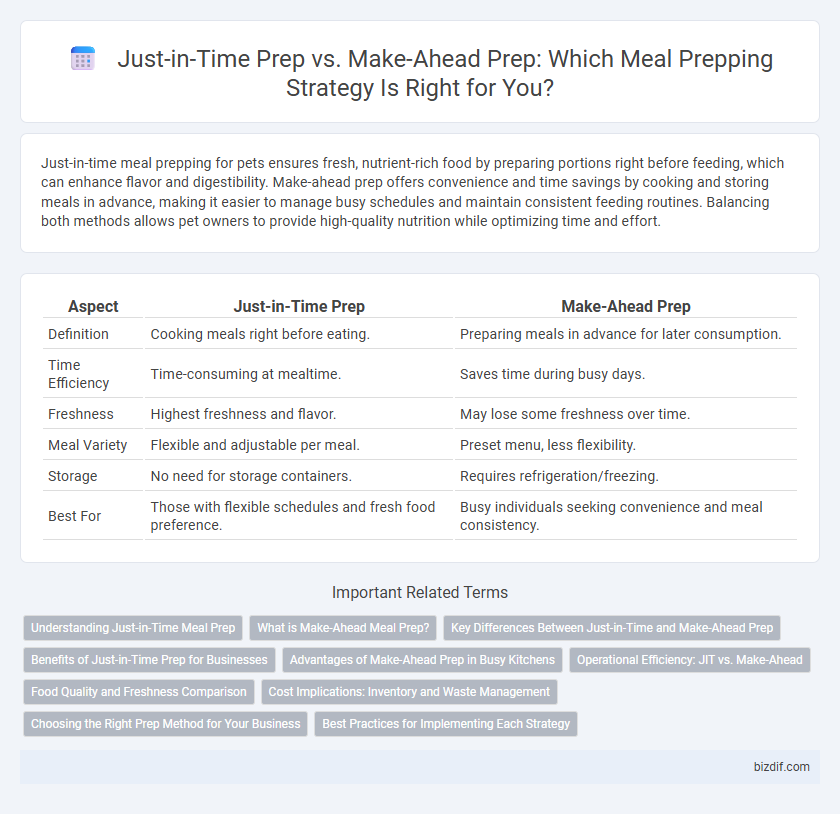Just-in-time meal prepping for pets ensures fresh, nutrient-rich food by preparing portions right before feeding, which can enhance flavor and digestibility. Make-ahead prep offers convenience and time savings by cooking and storing meals in advance, making it easier to manage busy schedules and maintain consistent feeding routines. Balancing both methods allows pet owners to provide high-quality nutrition while optimizing time and effort.
Table of Comparison
| Aspect | Just-in-Time Prep | Make-Ahead Prep |
|---|---|---|
| Definition | Cooking meals right before eating. | Preparing meals in advance for later consumption. |
| Time Efficiency | Time-consuming at mealtime. | Saves time during busy days. |
| Freshness | Highest freshness and flavor. | May lose some freshness over time. |
| Meal Variety | Flexible and adjustable per meal. | Preset menu, less flexibility. |
| Storage | No need for storage containers. | Requires refrigeration/freezing. |
| Best For | Those with flexible schedules and fresh food preference. | Busy individuals seeking convenience and meal consistency. |
Understanding Just-in-Time Meal Prep
Just-in-time meal prep involves preparing ingredients or meals immediately before consumption to ensure maximum freshness and nutrient retention, reducing food waste through precise portion control. This method relies on efficient planning and quick cooking techniques, often utilizing pre-chopped vegetables or pre-marinated proteins stored briefly to streamline the final cooking process. Just-in-time prep enhances flavor and texture by minimizing storage time, catering to diverse dietary preferences with customizable meal components prepared on demand.
What is Make-Ahead Meal Prep?
Make-ahead meal prep involves preparing and cooking meals entirely or partially in advance to save time during busy days. This method allows for bulk cooking, portioning, and storing meals in refrigerators or freezers, ensuring convenient access to nutritious food without daily cooking. It enhances efficiency by reducing meal-time stress and minimizing food waste through planned ingredient use.
Key Differences Between Just-in-Time and Make-Ahead Prep
Just-in-time prep involves preparing meals immediately before consumption, ensuring maximum freshness and optimal texture, ideal for perishable ingredients like leafy greens or seafood. Make-ahead prep focuses on cooking or assembling meals in advance, enhancing convenience and time efficiency during busy days, often utilizing methods such as refrigeration or freezing to preserve flavors. Key differences include timing, ingredient handling, and storage techniques, impacting meal quality, safety, and flexibility in daily meal planning.
Benefits of Just-in-Time Prep for Businesses
Just-in-time prep minimizes food waste and reduces inventory costs by preparing meals only as orders are received, enhancing operational efficiency for businesses. This approach improves freshness and customer satisfaction through timely meal delivery, ensuring ingredients retain optimal flavor and nutrition. Streamlining kitchen workflows with just-in-time prep allows businesses to allocate resources more effectively, boosting overall productivity and profitability.
Advantages of Make-Ahead Prep in Busy Kitchens
Make-ahead prep streamlines busy kitchen workflows by reducing last-minute cooking pressure and allowing for better time management. Prepping ingredients or entire meals in advance minimizes waste and ensures consistent portion control, enhancing efficiency. This method supports healthier eating habits by providing ready-to-eat nutritious options during peak hours.
Operational Efficiency: JIT vs. Make-Ahead
Just-in-time (JIT) meal prepping enhances operational efficiency by minimizing food waste and ensuring freshness through precise ingredient preparation only when needed. Make-ahead prep boosts productivity by batch cooking multiple meals in advance, reducing daily cooking time and enabling quick meal assembly. Balancing JIT and make-ahead methods optimizes timing, resource allocation, and reduces overall kitchen labor costs.
Food Quality and Freshness Comparison
Just-in-time meal prep maximizes food quality and freshness by cooking meals immediately before consumption, preserving texture, flavor, and nutrient content. Make-ahead prep offers convenience but may compromise freshness due to longer storage and reheating, potentially causing moisture loss and flavor degradation. Optimal meal planning balances just-in-time cooking for delicate ingredients with make-ahead options for sturdier dishes to maintain overall food quality.
Cost Implications: Inventory and Waste Management
Just-in-time meal prepping minimizes inventory costs by purchasing ingredients closer to their use, reducing spoilage and waste. Make-ahead prep requires larger upfront inventory, increasing the risk of excess perishable items but enabling bulk purchasing discounts. Efficient waste management in both approaches hinges on accurate demand forecasting and storage optimization to balance cost savings and food quality.
Choosing the Right Prep Method for Your Business
Choosing the right meal prep method depends on factors such as your business size, menu variety, and customer demand patterns. Just-in-time prep minimizes waste and ensures peak freshness by preparing meals shortly before delivery, ideal for customizable or perishable menus. Make-ahead prep leverages bulk cooking and efficient workflows for higher volume orders, reducing labor costs and streamlining production in businesses with predictable demand.
Best Practices for Implementing Each Strategy
Just-in-time prep emphasizes preparing ingredients or meals moments before consumption, optimizing freshness and minimizing food waste by aligning cooking with precise mealtime schedules. Make-ahead prep involves cooking and storing meals ahead of time, requiring airtight containers and refrigeration techniques to maintain flavor and nutritional value across days. Implementing just-in-time prep benefits from efficient workflow and timely ingredient availability, while make-ahead prep thrives with batch cooking, portion control, and proper storage protocols to ensure safety and convenience.
Just-in-time prep vs make-ahead prep Infographic

 bizdif.com
bizdif.com